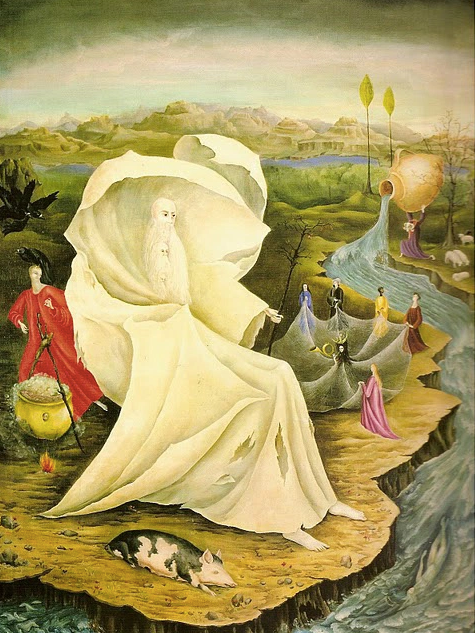1917-2011
Leonora Carrington was an English-born Surrealist artist, who created a mythical world of human-animal hybrids, fairytales, and symbolism in her oil paintings, cast iron sculptures, mixed-media sculptures, tapestries, and stories. Her fantastical imagination was influenced by myths learned as child from her Scottish mother and nanny.
She worked in the same painting style throughout her life. Her dreamlike, detailed compositions consisted of fantastic creatures and environments. Her work showed her sympathies towards mythology, the occult, and the animal world. She often used the hyena and the white horse to represent herself in her art. Her portrayals of women with wild hair – like her own – stood for freedom and sexuality.
The rebellious and self-possessed daughter of a British textile tycoon, Carrington was expelled from several convent schools. Eventually she was sent to study in Paris and absorbed the magnificent sculpture and paintings there. She was allowed to study art in London at the Chelsea School of Art and Ozenfant Academy until 1938.
Carrington was influenced by the Surrealists in the 1930s. In 1937, she met the Surrealist German artist Max Ernst who was 26 years her senior. The two bonded, lived, and worked together in southern France. The outbreak of World War II led to Ernst’s arrest as a hostile alien and his incarceration. After his escape he fled to America, and Carrington suffered a mental breakdown. She left France with friends, and as she attempted to cross into Spain suffered hallucinations. In Spain she deteriorated further and was gang raped and dumped in a Madrid park. She landed in a sanitarium where she was treated with electroconvulsive therapy.
After the war she met Ernst again, but he seemed less like a liberator and more like a drain on her energies. In 1942, she settled in Mexico and married photographer Chiki Weisz, with whom she had two sons. She immersed herself in mysticism and created a hub of female creativity with Kati Horna and Spanish Surrealist Remedios Varo. She worked in the same studio with Varo, who shared her interest in the occult, alchemy, and magical subjects.
Carrington’s recurring theme was woman as life force contrasted by malign forces in nature. Her works had echoes of early Renaissance religious art in allegory and mythology. She focused on magical realism and put autobiographical details into her paintings. She painted strange beings, half animal and half human, involved in rituals, all rendered in soft glowing tones that drew upon the techniques of the old masters.
Carrington had her first solo exhibition in Mexico City in 1950. Her surrealist novel, “The Hearing Trumpet,” written in the 1960s, was published in France in 1974 and has been newly reissued. The novel is built up on layers of different narratives with a shifting point of view much and has been described as a feminist “Alice in Wonderland” and as an alternative to “The Da Vinci Code.” It contains an embedded story to reveal varied hidden worlds. In 2013, Carrington was the subject of a major retrospective at the Irish Museum of Modern Art in Dublin.
Her work is in the permanent collections of the Metropolitan Museum of Art, the Prado Museum in Madrid, and New York”s Museum of Modern Art, which acquired her 1953 “And Then We Saw the Daughter of the Minotaur.” This work was put on view as a centerpiece in MoMA’s reconfigured Surrealist gallery.
More here.
